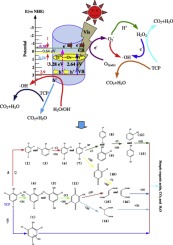Journal of the Taiwan Institute of Chemical Engineers ( IF 5.5 ) Pub Date : 2018-01-08 , DOI: 10.1016/j.jtice.2017.12.020 Xiaoyong Deng , Ruonan Guo , Huixuan Zhang , Bo Li , Qiuling Ma , Yuqi Cui , Xinyi Zhang , Xiuwen Cheng , Mingzheng Xie , Qingfeng Cheng

|
In the research, reduced TiO2 nano-tube arrays (denoted as R-TiO2 NTAs) photoelectrode was successfully fabricated by potassium borohydride (PBH) reduction treatment. Afterwards, the as-fabricated photoelectrode was characterized by scanning electron microscope, X-ray diffraction, Raman spectra and electron spin resonance. Meanwhile, the optical and photoelectrochemical properties of R-TiO2 NTAs photoelectrode were also studied through ultraviolet-visible diffuse reflectance spectroscopy and transient photocurrent response, respectively. The photocatalytic (PC) activity of R-TiO2 NTAs photoelectrode was measured by degradation of trichlorophenol (TCP). Moreover, the change of toxic intermediates in the process of degradation TCP was further evaluated by photobacterium inhibition tests. Results suggested that an impurity level can be induced in the TiO2 NTAs band gap by solution reduction treatment due to the generation of Ti3+ and oxygen vacancies (Ov). Furthermore, R-TiO2 NTAs photoelectrode exhibited higher PC activities than that of pristine TiO2 NTAs owing to the enhancement of visible light harvesting between 450 and 800 nm and separation efficiency of photogenerated electrons-holes (e/h+) pairs. The possible pathway for TCP degradation and photocatalytic mechanism were also proposed and confirmed. Furthermore, R-TiO2 NTAs photoelectrode displayed good stability and reusability.
中文翻译:

一种制备还原的TiO 2纳米管阵列光电极的简便策略及其对三氯苯酚溶液的解毒的高可见光光催化性能
在研究中,通过硼氢化钾(PBH)还原处理成功地制备了还原TiO 2纳米管阵列(称为R-TiO 2 NTAs)光电极。然后,通过扫描电子显微镜,X射线衍射,拉曼光谱和电子自旋共振对制成的光电极进行表征。同时,还分别通过紫外可见漫反射光谱和瞬态光电流响应研究了R-TiO 2 NTAs光电极的光学和光电化学性质。R-TiO 2的光催化(PC)活性通过三氯苯酚(TCP)的降解来测量NTAs光电极。此外,通过光细菌抑制试验进一步评估了降解TCP过程中有毒中间体的变化。结果表明,由于Ti 3+和氧空位(Ov)的产生,通过溶液还原处理可以在TiO 2 NTAs带隙中诱导杂质水平。此外,R-TiO 2 NTAs光电极表现出比原始TiO 2 NTA高的PC活性,这归因于可见光收集在450至800 nm之间的增强以及光生电子-空穴的分离效率(e / h +)对。还提出并证实了TCP降解的可能途径和光催化机理。此外,R-TiO 2 NTAs光电极显示出良好的稳定性和可重复使用性。











































 京公网安备 11010802027423号
京公网安备 11010802027423号